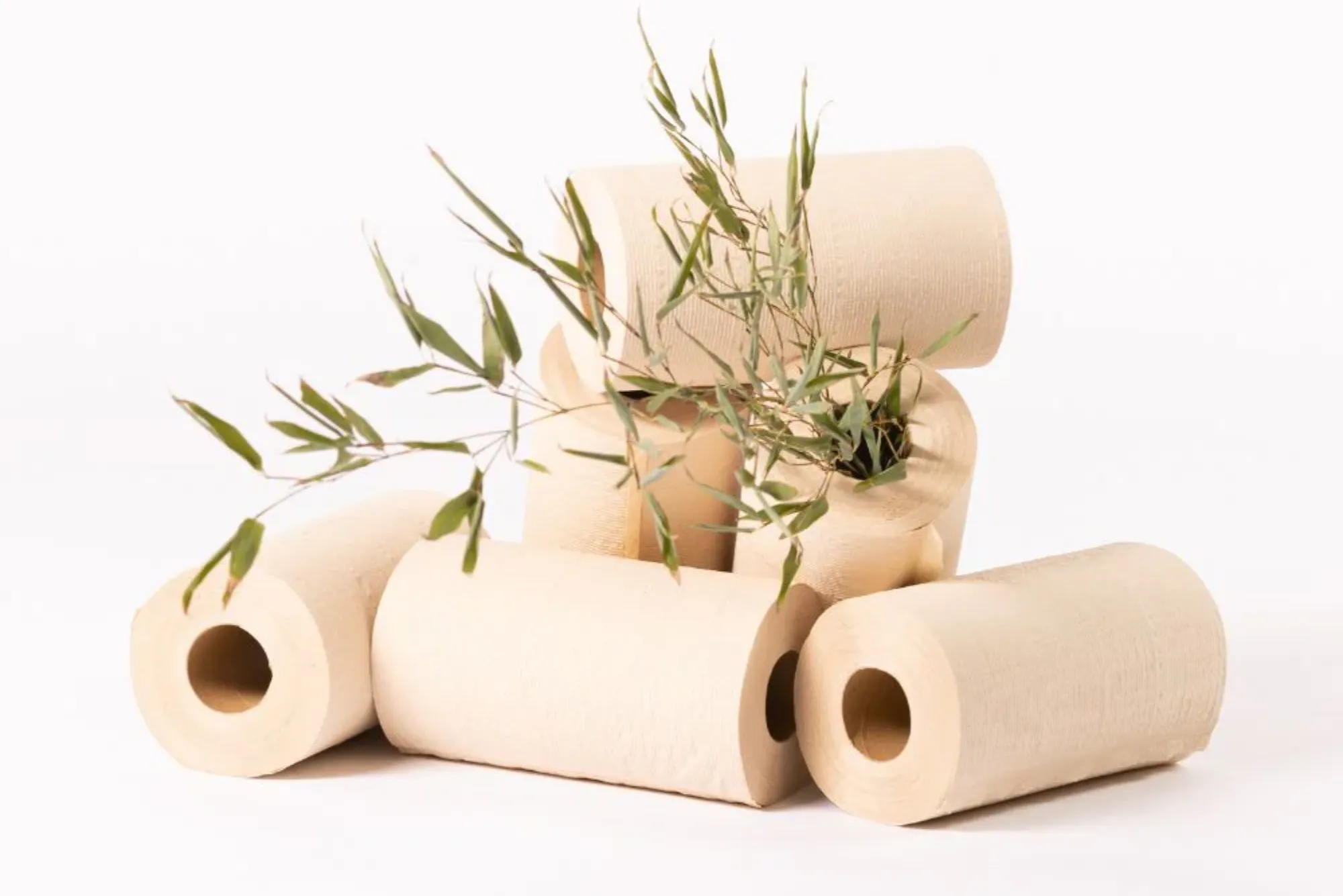Bamboo toilet paper has surged in popularity as an eco-friendly, sustainable, and skin-sensitive alternative to traditional wood-pulp toilet paper. Known for its soft yet sturdy texture, bamboo toilet paper is gentle on the skin and contributes to a more sustainable lifestyle by reducing deforestation. This article explores the journey from bamboo in the forest to the best bamboo toilet paper rolls in our homes, detailing each step in the production process and highlighting its benefits for both the environment and individuals with skin sensitivities.
Understanding Bamboo: A Sustainable Resource
Bamboo is a fast-growing grass that regenerates naturally without the need for fertilizers or pesticides, making it an ideal renewable resource. Unlike trees that take years, even decades, to mature, bamboo reaches full growth in as little as three to five years. This rapid growth rate allows bamboo to be harvested more frequently, reducing the environmental impact compared to traditional wood-pulp paper production. Furthermore, bamboo plants contribute to soil stabilization and produce up to 35% more oxygen than trees, making them a highly sustainable option.
Harvesting and Initial Processing of Bamboo
The process of creating bamboo toilet paper begins with the careful harvesting of mature bamboo stalks. These stalks are then transported to processing facilities where they undergo a series of treatments to break down the plant fibers. This initial processing typically involves cutting the bamboo stalks into smaller pieces, making them easier to process into pulp. Because bamboo is naturally pest-resistant, no harmful pesticides are introduced during the growth phase, ensuring a cleaner product for sensitive skin.
The bamboo pieces are then cooked at high temperatures to separate the fibers. This process not only softens the bamboo but also helps to remove lignin—a natural component that can make paper feel rough. Removing lignin and impurities makes the resulting pulp smoother and more suitable for producing toilet paper for skin sensitive users.
Pulping Process: Creating the Bamboo Fiber Pulp
Once the bamboo stalks are softened, they undergo a mechanical pulping process to transform them into a fibrous pulp. This step is crucial as it determines the texture and softness of the final product. The bamboo fibers are pulped using minimal chemicals, unlike traditional wood pulp processing, which often involves chlorine and other harsh bleaching agents.
The pulping process for bamboo is designed to retain its natural fibers while producing a soft, durable material. This is especially important for creating the best bamboo toilet paper that is gentle enough for those with sensitive skin. Bamboo’s natural fiber structure provides a balance of strength and softness, ideal for a comfortable and effective toilet paper.
The Bleaching Process: Ensuring Softness and Purity
After pulping, the bamboo pulp typically undergoes a bleaching process to achieve a clean, white appearance. Many bamboo toilet paper manufacturers use environmentally-friendly bleaching methods, such as hydrogen peroxide, instead of chlorine-based chemicals. Hydrogen peroxide is an oxygen-based bleach that safely removes impurities without producing harmful byproducts.
This eco-friendly bleaching process is gentle on the skin, making bamboo toilet paper suitable for individuals prone to allergies or sensitivities. Additionally, hydrogen peroxide bleaching helps maintain the natural strength of bamboo fibers, which ensures that the final product is both soft and durable, ideal for those seeking toilet paper for skin sensitive needs.
Sheet Formation: Crafting the Bamboo Paper Sheets
The next phase in the production process involves forming the pulp into sheets. The bamboo pulp is spread out into thin layers on large sheets, where it is dried and pressed to form a soft and smooth paper. Advanced machines help control the sheet thickness and texture, which are essential factors in determining the quality of the final product.
As the sheets are created, manufacturers may add an additional softening step to enhance the texture, creating an ultra-soft surface that doesn’t irritate sensitive skin. This results in a toilet paper product that combines strength with the gentle touch required for everyday use.
Rolling and Cutting: Transforming Sheets into Toilet Paper Rolls
Once the bamboo pulp has been processed into thin sheets, it is wound onto large spools. These spools are later cut into smaller rolls, which are then sized and shaped into standard toilet paper rolls. At this stage, manufacturers can decide on the thickness, ply, and roll size. For the best bamboo toilet paper, manufacturers often opt for a two-ply or three-ply structure, which adds extra layers for softness, strength, and durability.
The rolls are then packaged in eco-friendly, often recycled, materials. Many bamboo toilet paper brands prioritize using biodegradable packaging to further reduce their environmental footprint, ensuring the product aligns with the values of environmentally conscious consumers.
Benefits of Bamboo Toilet Paper for Sensitive Skin
Bamboo toilet paper offers a variety of benefits, particularly for those with sensitive skin. The unique properties of bamboo fibers make it naturally hypoallergenic, meaning it’s less likely to cause skin irritation compared to conventional paper. Additionally, the manufacturing process for bamboo toilet paper typically involves fewer harsh chemicals, such as chlorine and formaldehyde, which are commonly found in traditional wood-pulp paper production.
This gentle manufacturing process results in a product that is soft, gentle, and suitable for those prone to skin reactions. By using toilet paper for skin sensitive needs, individuals can reduce their exposure to chemicals and experience the comfort of a more natural, skin-friendly product.
Environmental Benefits of Using Bamboo Toilet Paper
In addition to being beneficial for sensitive skin, bamboo toilet paper is a sustainable alternative to traditional toilet paper. Bamboo’s rapid growth cycle allows it to be harvested without causing deforestation, making it an environmentally friendly choice. As a plant that requires no pesticides or excessive water, bamboo’s cultivation process has a much lower environmental impact.

Furthermore, bamboo toilet paper production requires significantly less water and energy compared to wood-pulp paper, further reducing its carbon footprint. The bamboo industry is often centered around sustainable practices, with many companies implementing ethical sourcing and fair trade practices to protect both the environment and local communities.
How Bamboo Toilet Paper Compares to Traditional Toilet Paper
When comparing bamboo toilet paper to conventional wood-pulp toilet paper, the advantages of bamboo are clear. Traditional toilet paper manufacturing typically involves cutting down trees, which depletes forests and contributes to global warming. In contrast, bamboo’s fast growth and regenerative qualities make it a renewable resource that can meet growing demand without harming the planet.
Additionally, bamboo toilet paper’s softer texture and hypoallergenic properties make it the preferred choice for those with sensitive skin. By choosing the best bamboo toilet paper, consumers are not only opting for a skin-friendly product but also making a responsible choice for the environment.
The production of bamboo toilet paper is a meticulous process that combines sustainable practices with innovative methods to deliver a soft, durable, and eco-friendly product. From the harvesting of bamboo to the final packaging, every step of the process is designed to minimize environmental impact while offering a high-quality product for consumers.
Bamboo toilet paper is a sustainable and skin-sensitive alternative that appeals to eco-conscious consumers and those seeking a gentle option for everyday use. The use of bamboo in toilet paper not only conserves natural resources but also creates a product that aligns with values of environmental responsibility and personal health. By choosing bamboo toilet paper, consumers are making a positive impact on both their well-being and the environment.



